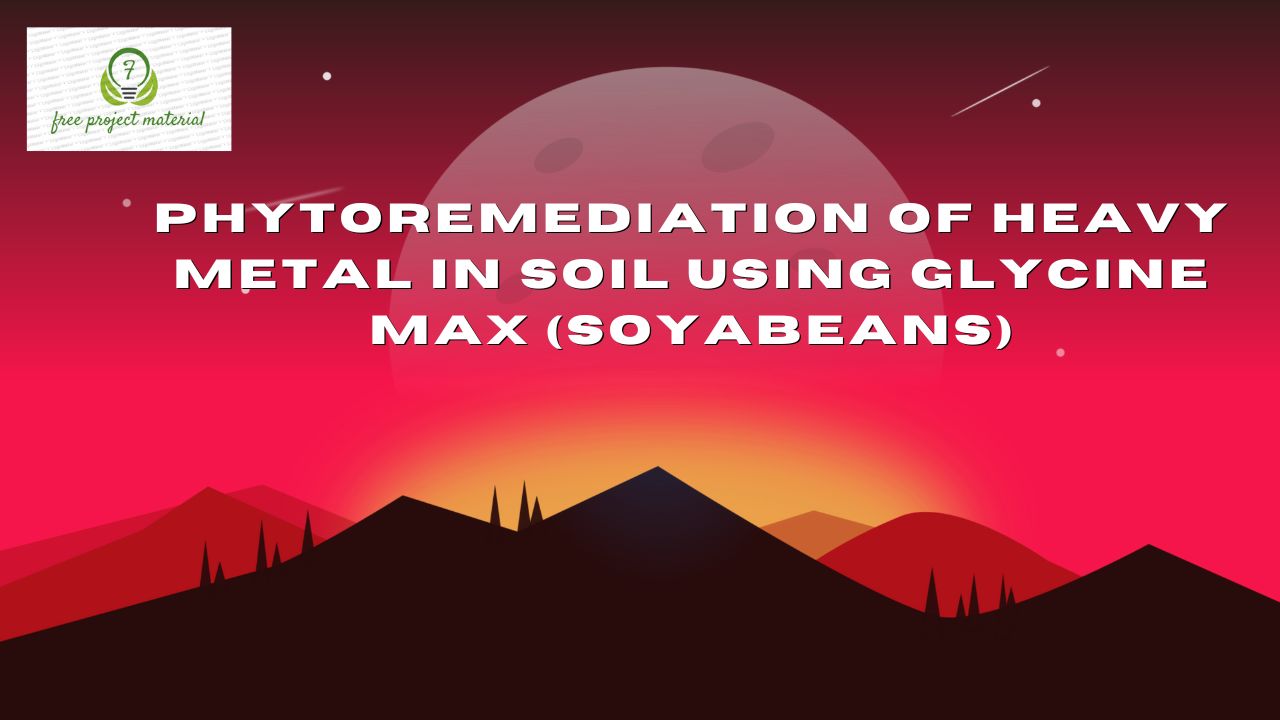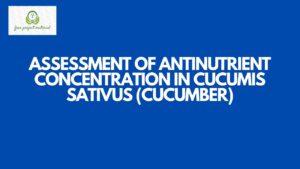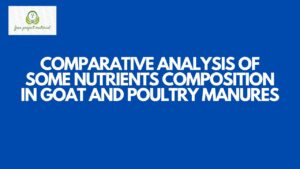ABSTRACT
The study was designed to determine the phytoremediation potential of heavy metal in soil using Glycine max. Pots experimental design was conducted. Loamy soil was collected using soil auger and sun-dried, sieved using 2µm sieve. 2kg of the sieved soil were transferred into six plastic pots labeled C, SC, SZn, SFe, ZnC and FeC respectively. The pots labelled SZn and ZnC were amended with zinc, SFe and FeC were amended with iron metal while C and SC were control soil. Viable seeds of Glycine max were planted in plots labeled SC, SZn and SFe respectively and watered daily. Heavy metal analysis was determined on the soil samples using the standard method of atomic absorption spectrophotometer. Iron (Fe) content of soybeans and soil recorded 2.10 mg/kg and 8.132 mg/kg, Zn recorded 0.863mg/kg and 4.237mg/kg for soybeans and soil respectively at day 0. Sample SFe, SZn, SC and C recorded. 26.187mg/kg and 8.201mg/kgm, 31.213mg/kg and 6.926mg/kg, 27.54mg/kg and 72.56mg/kg, 28.123mg/kg and 9.30mg/kg for iron and zinc respectively at day 9. Total bacterial count of amended soil samples were analyzed using pour plating method on nutrient agar plate. Result revealed bacterial count for SC, SFe and SZn respectively at 1.9×106cfu/g, 2.6×106cfu/g and 2.1×106 cfu/g; 2.8×106 cfu/g, 2.4×106cfu/g and 1.9×106cfu/g; 3.1×106cfu/g, 2.1×106cfu/g and 1.7×106cfu/g; 3.8×106cfu/g, 2.0×106cfu/g and 1.5×106cfu/g for day 0, 3, 6 and 9 respectively. Average plant growth parameters of the respective soil treatments were recorded. Plant height, leaves length and number of leaves result revealed 18m, 5.8cm and 3.0; 15.3m, 4.4cm and 3.0; 12.1m, 4.3 and 2.3 for sample SFe, SZn and SC respectively. The result revealed that a large proportion of the metal was removed from the soil as the plant keeps growing. Glycine max can be used for phytoremediation as it can be used for uptake of metals from the soil.
TABLE OF CONTENT
Title page – – – – – – – – – i
Certification – – – – – – – – – ii
Acknowledgement – – – – – – – iii
Abstract – – – – – – – – – iv
List of table – – – – – – – – v
Table of content – – – – – – – – vi
CHAPTER ONE
1.0 INTRODUCTION – – – – – – – 1
1.1 Aim and Objective – – – – – – – 1
CHAPTER TWO
LITERATURE REVIEW
2.0 Heavy metals – – – – – – 6
2.1 Sources of heavy metals in the soil – – – – 6
2.2 Effect of heavy metals in the environment – – – 10
2.3 Remediation of heavy metals contaminated soil – – 12
2.4 Mechanisms of heavy metals uptake by plants – – 14
2.5 Factors affecting metal uptake in plants – – – 16
2.6 Phytoremediation – – – – – – – 18
2.7 Mechanism of phytoremediation – – – – 19
2.8 Plant utilized metal remediation – – – – – 23
2.9 Glycine max – – – – – – – 25
2.10 Features of Glycine max – – – – – – 27
2.11 Cultivation of Glycine max – – – – – 28
2.12 Phytoremediation of metals from soil by Glycine max – 28
CHAPTER THREE
3.0 MATERIAL AND METHODS
3.1 Sample Collection – – — – – – 32
3.2 Sample Preparation – – – – – – 32
3.3 Bacteriological Analysis – – – – – 33
3.4 Heavy Metal Analysis – – – – – – 34
3.5 Statistical Analysis – – – – – – – 35
CHAPTER FOUR
4.0 RESULT AND DISCUSSION
4.1 Result – – – – – – – – 36
4.1.1 Total Bacterial count of soil treatments (CFU/g) – – 36
4.1.2 Statistical analysis of treatment effects on bacterial counts – 36
4.1.3 Plant growth parameters in soil treatments – – – 37
4.1.4 Statistical analysis of treatment effect on plant
growth parameters – – – – – – – 37
4.1.5 Heavy Metals Contents of treatments – – – – 37
4.1.6 Statistical analysis of treatment effects in heavy metal content – 38
4.2 Discussion – – – – – – – – 45
CHAPTER FIVE
5.0 CONCLUSION AND RECOMMENDATIONS
5.1 Conclusion – – – – – – – – 53
5.2 Recommendations – – – – — – – 53
References
LIST OF TABLES
Table 4.1: Total bacterial count of soil treatment – – – 39
Table 4.2: Statistical analysis of treatment effect
on bacterial counts – – – – – – 40
Table 4.3: Plant growth parameters in soil treatments – – 41
Table 4.4: Statistical analysis of treatment effects on plant
growth parameters – – – – – – 42
Table 4.5: Heavy metals content of soil treatment – – 43
Table 4.6: Statistical analysis of treatment effects on heavy
metal contents – – – – – – 44
CHAPTER ONE
1.0 Introduction
Heavy metals are group of toxic metals and metalloids associated with pollution and toxicity (Alloway, 1990). Heavy metals in the soil include some significant metals of biological toxicity such as mercury (Hg), cadmium (cd), lead (Pd), chromium (Cr) and arsenic (As). They also include other heavy metals of certain biological toxicity such as zinc (Zn) copper (Cu), nickel (Ni), stannum (Sn) and vanadium (v). In recent years, with the development of global economy, both type and content of heavy metals in the soil caused by human activities have gradually increased, resulting in the deterioration of the environment Ravan et al., (1998). Contamination of soil by heavy metals occur as a result of different anthropogenic activities such as mining, irrigation with waste water, disposal of solid wastes including sewage sludge, application of metal containing pesticides and the use of fertilizers. Toxicity of heavy metal range from severe illness to death of both plants and animals leading consequently to losses in soil fertility (Pehlillan et al., 2005). The health of plants including legumes like soya beans and groundnut growing in metal enriched soil is adversely affected due to nutrient deficiency or due to direct effects of toxicants. Higher concentrations of metals have shown toxicity to various physiological processes like synthesis of chlorophyll pigments in various plants including legumes severe reduction in crop yields (Chang et al., 2009).
Phytoremediation often referred as botanical bioremediation or green remediation is the use of plants to remove pollutants from the soil or to render them harmless. Phytoremediation is being considered as a new highly promising technology for the remediation of polluted sites (Minguzzi and Verghano, 1988). Phytoremediation is currently divided into areas such as phytoextraction, rhizofiltration, phytostabilization, phytovolatilization and phytodegration.
Phytoremediation has become an effective and affordable technological solution used to extract or remove inactive metals and metal pollutants from contaminated soil. This technology is environmental friendly and potentially lost effective. Phytoremediation takes the advantage of the unique and selective uptake capabilities of plant root systems together with translocation, bioaccumulation and contaminant degradation abilities of the entire plant body. Many species of plants such as Glycine max, Alphine Pennygrass, Indian mustard, Buffalo grass, Western wheatgrass, Spiracia oleracea, zea mays etc. have been successful in absorbing contaminants such as lead, cadmium chromium, arsenic and various radionuclides from soil Glycine max (soyabean) is an annual legume of the pea family fabaceae). Soyabean is economically the most important bean in the world which provides vegetable protein for millions of people and ingredients for hundreds of chemical products. Soyabean can be processed into margarine, shortening and vegetarian. Abhilash et al., (2016) reports about the mobility, bio-avalability and phytoremediational response of Spiracia oleracea and Zea mays of heavy metals in industrial contaminated soil of mysuru city. (Jabeen et al., 2009).
A Sesan et al., (2013) designed a study to assess the experimental potential of Glycine max for lead (Pb). Soil sample was placed in each plastic pot labeled OPP (control), 5ppm, 10ppm, 15ppm, 20ppm and 25ppm of lead respectively. The study was carried out for a period of 12weeks under natural conditions. The result revealed that pH, phosphorus and moisture contents increased while nitrogen and organic carbon contents decreased in polluted soil remediation with Glycine max compared to the unpolluted soil. The results suggested that Glycine max has phytoextraction ability and could be used in restoring soil polluted with lead.
Oluwafemi et al., (2017) investigated the remediation of lead and zinc polluted soil using Arachis hypogea and Glycine max. the presence of lead and zinc in Arachis hypogea and G. max seeds was determined using AA safter 0,4,8 and 12 weeks. 27.47mg and 20 1.49mg of lead were obtained in A. hypogaea at week 4 when 50mg and 250mg of lead was treated with the soil. The result concluded that the plants were able to uptake various concentrations of lead and zinc.
The present study therefore seeks to assess the phytoremediation of heavy metals in soil using Glycine max.
1.1 Aims and Objectives
The aim of this research work is to assess the phytoremediation of heavy metals in soil and objectives are:-
- To amend soil with different metals
- To determined the effect of metal amendment in soil on plant (Glycine max) growth parameters
- To determine the effect of metal amendment in soil on bacterial counts
- To determine the metal uptake capacity of Glycine Max growing in metal amended soil.


